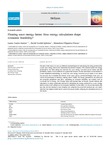Floating Wave Energy Farms: How Energy Calculations Shape Economic Feasibility?

Use this link to cite
http://hdl.handle.net/2183/40261
Except where otherwise noted, this item's license is described as Attribution-NonCommercial-NoDerivatives 4.0 International
https://creativecommons.org/licenses/by-nc-nd/4.0/
Collections
- Investigación (EPEF) [590]
Metadata
Show full item recordTitle
Floating Wave Energy Farms: How Energy Calculations Shape Economic Feasibility?Date
2024-11-30Citation
L. Castro-Santos, D. Cordal-Iglesias, A. Filgueira-Vizoso, Floating wave energy farms: How energy calculations shape economic feasibility?, Heliyon 10 (2024) e39672. https://doi.org/10.1016/j.heliyon.2024.e39672.
Abstract
[Abstract]: The aim of this study is to use two different methodologies for calculating the energy produced by a total wave energy farm in the Cantabrian Sea (North of Spain). First method studies the energy produced by the farm taking into account the wave energy converter power matrix and the probability matrix of sea conditions for a particular location. On the other hand, second method is a more simplified methodology in which the wave energy converter power matrix is not taken into account, but it considers the density of the water, gravity, period and height of the wave, as well as the percentage of efficiency, among others. Finally, the energy generated by the farm and the economic parameters that allow calculating its economic feasibility are studied, such as Levelized Cost of Energy, Net Present Value and Internal Rate of Return. Results indicate the importance of using a particular method for calculating the energy produced by a wave energy farm in terms of the variation of its economic feasibility. In this sense, it is shown that despite the fact that the first method is more detailed, the variations between both methods are very small, therefore the simplest model can be used in the future studies, reducing the calculation process in
the future.
Keywords
Floating wave energy farm
Energy production
Levelized cost of energy
Net present value
Internal rate of return
Energy production
Levelized cost of energy
Net present value
Internal rate of return
Editor version
Rights
Attribution-NonCommercial-NoDerivatives 4.0 International
https://creativecommons.org/licenses/by-nc-nd/4.0/
ISSN
2405-8440
Related items
Showing items related by title, author, creator and subject.
-
Estudo enerxético e proposta de mellora dun edificio residencial situado en Touro (A Coruña)
Ares Igrexas, Iván (2021)[Resumo] O presente traballo ten a finalidade a de ser o proxecto de fin de grao da titulación do Grao en Arquitectura Técnica na Universidade da Coruña. A realización do mesmo foi supervisada polos profesores Juan Luís ... -
Methodology to Calculate the Costs of a Floating Offshore Renewable Energy Farm
Castro-Santos, Laura; Martins, Elson; Guedes Soares, Carlos (Multidisciplinary Digital Publishing Institute, 2016)This paper establishes a general methodology to calculate the life-cycle cost of floating offshore renewable energy devices, applying it to wave energy and wind energy devices. It is accounts for the contributions of the ... -
An approach to Energy Planning in Germany - Energy Transition towards a low-carbon economy: Analysis and application of Modern Portfolio Theory to the German Electricity Mix
Afonso Arévalo, Javier Eduardo (2020)[Abstract]: The targets of this Final Degree Thesis are to explain the current situation of the German Energy Sector, its evolution over time, to compare its features with the European Union Energy Sector, and finally, to ...






